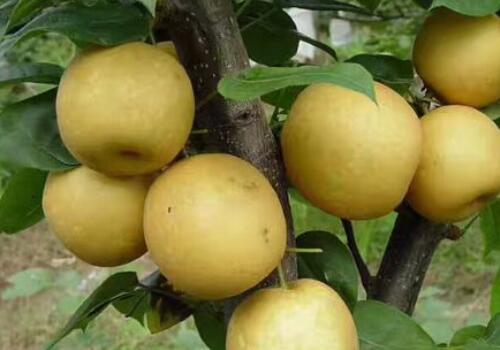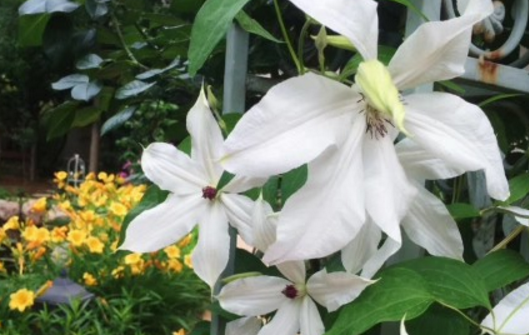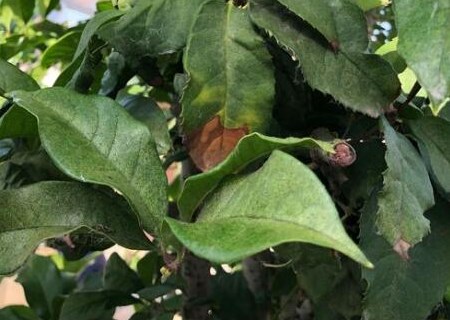How much is the price of "June Snow" Cuiguan pear seedlings? How many years has it been planted? What are the places of origin? The prospect of development is as follows
Cuiguan pear is a honey pear, also known as "June snow", with thin skin, crisp and juicy flesh, thick and tender taste and sweet juice. It was listed 2 to 3 months earlier than Yali pear and Dangshan pear in the north. How much is the Cuiguan pear seedling? How many years has it been planted? What are the places of origin? What are the development prospects? It is learned from Mr. he, a grower of Cuiguan pear in Shandong Province, that it generally sprouts in mid-March, blossoms in late March and ripens in late July. After grafting and planting seedlings, the flowers and fruits were tested in the second year, and officially put into production in the third year.

How much is the price of Cuiguan pear seedlings?
Cuiguan pear belongs to sand pear series, the fruit is nearly round, the fruit shape index is 0.96, yellowish green, snow-white flesh, delicate flesh, soft succulent, cinder, few stone cells, strong sweet taste, soluble solids content 12% 14%, high quality, single fruit weight 200 grams, maximum 500 grams, fruit edible rate 96%, seedling rice diameter 6 cm price about 1.3 yuan.
What are the producing areas of Cuiguan pear?
1. Cuiguan pears are distributed in all provinces, municipalities and autonomous regions in China, from north to south and from east to west. It is listed on the market in the first and middle of July, the fruit is flat and round, the fruit surface is clean, the flesh is white, the fruit core is thick, tender and fresh, the juice is rich and sweet, the flavor is honey, and it has a good reputation as "the family of a hundred fruits". The variety matured early, the fruit growth period was 110 days, and matured in late July, more than 20 days earlier than Huanghua pear and more than 2 months earlier than northern Yali pear. The fruit is large, with an average fruit weight of more than 230 grams, with a maximum of 450 grams.
2. The average yield per mu is 2500-3500 kg, and that of high-yielding orchard is 7500-10000 kg per mu, and the yield of fruit is more than 500kg in north-south pear producing areas. The economic life of pear is long, the normal fruit life is 40-50 years, and the elderly is more than 100 years. Pear fruit is very resistant to storage and transportation, so producers do not have to worry about rotten fruit when it is difficult to sell.
What are the prospects for the planting and development of Cuiguan pear?
The main results are as follows: 1. The fruit of Cuiguan pear is nearly round, the fruit is large, the average weight of single fruit is 230 g, the maximum weight of single fruit is 400 g, the fruit is green, the bagged fruit is yellow, and the fruit surface is smooth. The peel is thin, the core is small, the flesh is white, the flesh is tender, the juice is much, the taste is sweet, the quality is high, and the content of soluble solids is 12%-13%. Cuiguan pear has the functions of clearing heart, moistening lungs, reducing fire, promoting fluid, moistening dryness, clearing heat, resolving phlegm and so on. It contains a variety of nutrients, such as protein, fat, carbohydrates, vitamins B1, B2, C and other organic ingredients. It also contains potassium, sodium, calcium, magnesium, selenium, iron, manganese and other inorganic components and dietary cellulose. It can be stored for 15 days and refrigerated for up to 40 cents for 60 days.
2. Pear contains a variety of nutrients, such as vitamin C4 mg, vitamin P0.1 mg, vitamin B10.02 mg, vitamin B20.01 mg, carotenoid 0.01mg, protein 0.1g, fat 0.1g, sugar 9g, crude fiber 0.6g, ash 0.4g, calcium 5mg, phosphorus 6mg, iron 0.2mg, calorie 217KJ.
3. Pears are not only nutritious, but also considered in traditional Chinese medicine to be sweet and cold, moistening the lungs, clearing the heart, relieving cough, eliminating phlegm, relieving lung heat, fire, alcoholic poison, chest tightness and shortness of breath, etc.; according to the Compendium of Materia Medica, it can be used for colds, bronchitis, cough, thirst, apnea, constipation, alcohol detoxification, etc.
Cuiguan pear taste delicious, in Macao and other big cities, the sales price often reached more than 10 yuan per jin, the planting market is broad.
Attached: fertilizer and water management measures of Cuiguan pear
Cuiguan pear is an early-maturing variety, which has high requirements for fertilizer and water. Reasonable fertilizer and water management measures are the guarantee of high yield and high quality.
1. Fertilization technology
(1) Base fertilizer: pear fertilizer is mainly based on base fertilizer. Base fertilizer can be applied in autumn and winter, and it is best to apply it in autumn after fruit harvest to before defoliation. The application of base fertilizer in autumn is beneficial to root wound recovery and new root growth, and can prevent freezing and sprout ahead of time after absorbing some fertilizer. It can be applied according to 35-50 kg of organic fertilizer per plant and 1 kg of superphosphate.
(2) topdressing: generally applied three times a year, that is, pre-flowering fertilizer, strong fruit fertilizer and pre-harvest fertilizer. Pre-flowering fertilizer, mainly nitrogen fertilizer after budding and before flowering, can promote the growth of branches and leaves and increase the rate of fruit setting. Less nitrogen fertilizer should be applied to newborn trees and prosperous trees. Strong fruit fertilizer, after the new shoot stops growing, nitrogen and potassium fertilizer, combined with phosphate fertilizer, is beneficial to flower bud formation and fruit expansion. Pre-harvest fertilizer is carried out before fruit harvest, and the combined application of phosphorus and potassium is beneficial to improve fruit quality and prepare for sprouting, flowering and fruiting in spring next year. Or look at the trees and apply fertilizer in stages. At 20 days after flowering, fruit expansion period (May-June) and 20-30 days before harvest (early July), 1-2 kg compound fertilizer was applied to each plant. 100-150 grams per young tree and 250-500 grams per adult tree. It can also be combined with spraying root topdressing 0.3% Mel 0.5% potassium dihydrogen phosphate, or 0.3% Mel 0.5% potassium sulfate. 0.1% Mel 0.3% agricultural borax can be sprayed during flowering to improve fruit setting rate and prevent fruit cracking.
2. Water management: pear trees have a relatively large demand for water in four periods: before and after germination to pre-flowering, after flowering, in the middle and later stage of fruit growth, before and after fruit harvest to before defoliation. Among them, the post-anthesis young fruit expansion stage is the critical period of water requirement for pear trees. Timely irrigation can promote the growth of new shoots and leaves, expand the assimilation area, enhance photosynthesis, increase fruit setting rate and increase fruit, and has a good effect on flower bud differentiation in the later stage.
Time: 2019-03-16 Click:
- Prev

Culture methods and matters needing attention of clematis of Ranunculaceae? Taboos on farming in winter? The difference between rotor lotus and rotor lotus?
Clematis like fertile, well-drained alkaline loam, avoid stagnant water, so clematis culture methods and matters needing attention? Taboos on farming in winter? The difference between rotor lotus and rotor lotus? It is understood that clematis has strong cold resistance and can withstand the low temperature of-20 ℃. But they are often harmed by leaf-eating diseases such as red spiders.
- Next

What if the leaves of the traditional sweet-scented osmanthus trees are dry and yellow? Why can't you grow it at home? How to grow well?
Sweet-scented osmanthus is a common name for many trees of the genus Oleaceae in China. It is an evergreen shrub or small tree of Oleaceae. It has a wide variety of gardening, so do you know what to do when the leaves of sweet-scented osmanthus are withered and yellowed during planting? Why can't you grow it at home? How to grow well? What about the withered and yellow leaves of sweet-scented osmanthus trees?
Related
- Fuxing push coffee new agricultural production and marketing class: lack of small-scale processing plants
- Jujube rice field leisure farm deep ploughing Yilan for five years to create a space for organic food and play
- Nongyu Farm-A trial of organic papaya for brave women with advanced technology
- Four points for attention in the prevention and control of diseases and insect pests of edible fungi
- How to add nutrient solution to Edible Fungi
- Is there any good way to control edible fungus mites?
- Open Inoculation Technology of Edible Fungi
- Is there any clever way to use fertilizer for edible fungus in winter?
- What agents are used to kill the pathogens of edible fungi in the mushroom shed?
- Rapid drying of Edible Fungi

